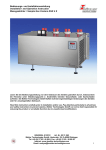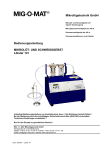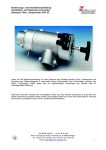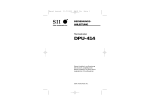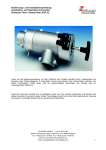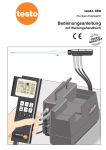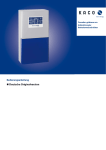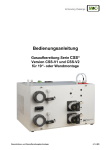Download Bedienungsanleitung de Instruction manual en
Transcript
Gasaufbereitung testo 339 Bedienungsanleitung Instruction manual de en Gasaufbereitung für Dauermessungen an Industrie-Feuerungsanlagen Inhalt Beschreibung ............................................................................................3 Warum eine Gasaufbereitung................................................................3 Funktionsprinzip....................................................................................3 Warnhinweise ...........................................................................................4 Frontansicht...............................................................................................5 Beschreibung Leuchtdioden.....................................................................6 Ansicht Geräterückseite............................................................................7 Inbetriebnahme..........................................................................................8 Messung...................................................................................................10 Normalbetrieb/Automatikbetrieb .........................................................10 Betrieb der Gasaufbereitung ohne Beheizung des Gasentnahmeschlauches (Sonderbetrieb) ...................11 Zugmessung in Verbindung mit testo 33 ............................................11 NO -Messung .....................................................................................11 2 Betriebszustände.....................................................................................12 Einschaltphase....................................................................................12 Betriebsphase.....................................................................................12 Reinigungsbetrieb ...............................................................................13 Betrieb der Gasaufbereitung ohne Beheizung des Gasentnahmeschlauches (Sonderbetrieb) ...................13 Störmeldebetrieb ...............................................................................13 Störungen Ursache und Behebung ......................................................................14 Gasentnahmeschlauch............................................................................16 Reinigung Gausaufbereitung ...............................................................................17 Gasentnahmeschlauch .......................................................................18 Rauchgassonde..................................................................................18 Wartung Wechsel der Lüfterfilter............................................................................................19 Sicherungen .......................................................................................19 Pumpenkassette.................................................................................20 Filterwechsel Gasentnahmeschlauch ..................................................20 Technische Daten....................................................................................21 Bestelldaten ............................................................................................22 Garantie ...................................................................................................22 Meßgerät konform zu EN 50 082 - 1 / EN 55 011 Gruppe 1 Klasse A, EN 61 010 - 1 Beschreibung Warum eine Gasaufbereitung? Bei Abgas-Messungen an Feuerungsanlagen über einen längeren Zeitraum führt in der Regel entstehendes Kondensat zu ungenauen NO2- und SO2-Gehaltsangaben. Zur Kondensatbildung kommt es, weil der Wasser- bzw. der Säuretaupunkt innerhalb des Gasweges unterschritten wird. Das Kondensat schlägt sich in Filtern oder in Schläuchen nieder und absorbiert (bindet) NO2- und SO2--Anteile (die Meßwerte werden verfälscht). Funktionsprinzip Die tragbare Gasaufbereitung testo 339 ist für das RauchgasAnalsengerät testo 33 konzipiert und wird zwischen der Rauchgas-sonde und dem Analysegerät angeschlossen. Partikelfilter Schlauch beheizt (2,20 m und 4,0 m Länge) Innen-Seele (PTFE) testo 339 Temperaturregelung Schlauchpumpe Tygon® - Verbindungsschlauch zum testo 33 (0,4 m Länge) Netzteil 90 ... 260 Volt Anzeige- und Überwachungselektronik Gasumschaltventil testo 33 Die Aufbereitung des Meßgases über das testo 339 führt zu einer Reduzierung der Absorption bis auf ein Minimum. Der beheizte Partikelfilter und der anschließend ebenfalls beheizte Gasweg halten das Rauchgas auf einer Temperatur von +150 °C - bis das Meßgas im Gaskühler mittels eines Peltierelmentes auf einen Taupunkt von +3...+6 ° C abgekühlt wird. Das dabei entstehende Kondensat wird in das optionelle Kondensatgefäß abgepumpt. Das bereits gereinigte und nun auf einen Restfeuchtegehalt getrocknete Meßmedium wird in dem Analysegerät des testo 33 analysiert. TUV. SUDWEST geprüfte Sicherheit Der Prüfung des Technischen Überwachungs-Vereins (Bericht GEM1-GE-17.2/1/1613/92) in Bezug auf elektrische Sicherheit, Funkstörverhalten, Störfestigkeit Industriebereich (EMV) lagen folgende Normungen zugrunde: Elektrische Sicherheit DIN VDE 0411 Teil 1/10.1973 bzw. DIN VDE 0411 Teil 1a/02.1980 Funkstörverhalten PostVfg. 1046 (DIN VDE 0871) Störfestigkeit Industriebereich (EMV) IEC 801 Teil 2, 3, 4, 5 prEN 50 082-2. 3 Warnhinweise Vor Inbetriebnahme bitte unbedingt lesen und beachten: Die Gebrauchslage des Geräts ist immer waagrecht. Das Gerät darf nicht in explosionsgefährdeten Bereichen betrieben werden. Beachten Sie die Angaben unter "Technische Daten". Prüfen Sie anhand des Typenschildes ob Typ, Netzspannung und Leistung mit den tatsächlichen Gegebenheiten übereinstimmen. Ein Betreiben des Schlauches in Ausführung 110 V~ an Netzspannung 230 V~ führt zur Zerstörung d. Gasentnahmeschlauches. Der Betrieb eines Schlauches in 230 V~ Ausführung an 110 V~ Netzspannung führt nicht zu den notwendigen Solltemperaturen. Die zulässigen Brennstoffe für die Gasaufbereitung sind: Heizöl EL, Heizöl S, Erdgas, Flüssiggas, Koks, Brikett, Braunkohle, Steinkohle, Kokereigas und Stadtgas. Bei anderen Brennstoffen ist darauf zu achten, daß hochaggressive Stoffe wie z. B. Fluor und Halogenverbindungen die Werkstoffe des Gaswegs angreifen können. Die seitlichen Lüftungsschlitze müssen offen liegen. Auf einen minimalen Zustand von 30 mm zu anderen Gegenständen ist zu achten. Außerdem sollte das Gerät nicht in kleinen, geschlossenen, nicht durchlüfteten Gefäßen oder Behältern betrieben werden. testo 339 erst nach dem Anschluß des Gasentnahmeschlauches einschalten! Der Gasentnahmeschlauch sollte keinen Zugbeanspruchungen ausgesetzt werden und darf nicht von außen erwärmt werden. Vorsicht! Oberfläche der Schlauchleitung (insbesondere im Bereich des Filtergehäuses erhitzt sich bei Betrieb. Bei Befestigung des Gasentnahmeschlauches mit Schellen oder ähnlichen Teilen muß darauf geachtet werden, daß der äußere Aufbau der Schlauchleitung nicht zusammengedrückt wird. Wird der Außendurchmesser um mehr als 10 % verringert, werden Heizleiter, Steuerleitungen und Fühlerleitungen beschädigt. Die Umgebungstemperatur darf über die gesamte Schlauchlänge nicht um mehr als 20 ° C differieren. Um eine zu starke Abkühlung zu vermeiden, muß die Leitung im Freien windgeschützt verlegt werden. Die Schutzumflechtung der Schlauchseele besteht aus dünnen Drähten, die zu einem Schlauch geflochten sind. Vermeiden Sie herausragende Nägel, scharfe Kanten oder ähnliches in der Umgebung des Gasentnahmeschlauches. Der Schutzmantel und die Einzeldrähte können dadurch beschädigt werden. Betreiben Sie den Schlauch grundsätzlich nur mit Partikelfilter! Betrifft nur die 4m-Ausführung 0401.0395: Die Kupplungsstelle zwischen Rauchgassondenleitung und Verlängerungsleitung 0554.0341 muß mindestens einen Abstand von 15 cm zum beheizten Gasentnahmeschlauch haben, da es ansonsten zu Fehlmessungen der Raum- und Abgastemperatur kommen kann. Gasaufbereitung testo 339 Frontansicht Gasausgang bzw. Anschlußverschraubung für den Verbindungsschlauch zum Analysegerät testo 33. Gaseingang Anschluß des Gasentnahmeschlauches (von Rauchgassonde kommend). elektrische Anschlußbuchse Gasentnahmeschlauch POWER ON Service-Taster Service LED 1 Kondensatpumpenkassette LED 2 testo 33 LED 3 LED 4 LED 5 LED 6 LED 7 LED 8 LED 9 AUTOMATIC off on Ansaugstutzen AutomatikIm Automatikbetrieb Schalter wird hier Frischluft zur Regenerierung bzw. Kalibrierung der Zellen angesaugt. 5 testo 339 testo term Kondensatausgang Beschreibung Leuchtdioden (LED) Die Frontplatte des testo 339 ist mit neun verschiedenfarbigen 8-mmLeuchtdioden bestückt, die den Benutzer über die Betriebsphase bzw. Betriebszustand des Gerätes informieren. Die gelben und grünen LED weisen auf einen Betriebszustand hin, während die roten LED grundsätzlich Warnungs- bzw. Fehlerzustände verdeutlichen. LED 1: leuchtet ➝ Gerät eingeschaltet (gelb) LED 2: Sie gibt an, ob das Gerät betriebsbereit ist und in welchem (grün) Schaltzustand sich das interne Gasumschaltventil befindet. erloschen: das Gerät ist nicht betriebsbereit leuchtet: das Gerät ist betriebsbereit, der Gasweg ist auf Rauchgas geschaltet. blinkt: das Gerät ist betriebsbereit, befindet sich im Automatikbetrieb und das interne Gasumschaltventil ist auf Frischluft geschaltet. LED 3: leuchtet ➝ Die Umgebungstemperatur entspricht nicht den (rot) zulässigen Werten (siehe Angaben in "Technische Daten"). LED 4: Das Leuchten dieser LED kann verschiedene Ursachen (rot) haben: - Defekt des Gasentnahmeschlauches (führt zur Abschaltung) - Betrieb der Gasaufbereitung ohne elektrischen Anschluß des Gasentnahmeschlauches (Sonderbetrieb) - Unerlaubter Anschluß des Gasentnahmeschlauches im Reinigungsbetrieb (LED blinkt) LED 5: leuchtet ➝ die beheizte Schlauchleitung des Gasentnahmeschlauches erreicht nicht mehr die geforderte Temperatur. Dieser Fehler führt zum Abschalten des Gerätes testo 339. (rot) LED 6 : Die Schlauchleitung des Gasentnahmeschlauches wird aufgeheizt. (gelb) (LED leuchtet) bis die Betriebstemperatur erreicht ist (LED blinkt). LED 7: leuchtet ➝ Die Lüfterfilter (Geräterückseite) sind verstopft. (rot) Dieser Fehler führt zum Abschalten des Systems. LED 8: leuchtet ➝ Ein systembedingter Fehler führte zur Abschaltung (rot) der Gasaufbereitung. LED 9: Das Kühlsystem des testo 339 wird mit Spannung versorgt (gelb) (LED leuchtet) bis die Betriebstemperatur erreicht ist (LED blinkt). 6 Ansicht Geräterückseite Sicherungshalterung Netzschalter Netzanschluß Erdungsbuchse Lüfterfilter Wartungsschnittstelle Inbetriebnahme Zur Inbetriebnahme sind folgende Komponenten erforderlich: - Gasaufbereitung testo 339 - Netzkabel (testo 339) - beheizter Gasentnahmeschlauch - Verbindungsschlauch (Gasaufbereitung testo 339 -Analysegerät testo 33) - testo 33 mit Analysegerät und Rauchgas-Sonde Wir empfehlen zusätzlich: - Kondensat-Auffanggefäß (Option, siehe Zubehör) Das Gerät testo 339 erst nach dem Anschluß des Gasentnahmeschlauche einschalten! POWER ON SERVIC testo 33 testoterm testo 339 AUTOMATIC D-7825 Lenzkirch W ¡C t testoterm GmbH & Co. Die Gasleitung der Rauchgassonde (rot gekennzeichnet) wird durch den beheizten Gasentnahmeschlauch ersetzt. Am ersten Gasabgang der Rauchgassonde Schlauch abnehmen und den beheizten Gasentnahmeschlauch anschließen. An der Gasaufbereitung Konus der beheizten Schlauchleitung einschieben und Überwurfmutter mit leichter Handkraft aufschrauben und den elektrischen Anschluß stecken. Der Gasweg wird über die Gasaufbereitung testo 339 umgeleitet. Der im Lieferumfang enthaltene Verbindungsschlauch leitet das Meßgas vom testo 339 (Gasausgang) zum Gaseingang des Analysegerätes testo 33. Stellen Sie das Analysegerät auf oder neben die Gasaufbereitung (Mindestabstand von 30 mm beachten!). Stecken Sie das Netzkabel des Gasaufbereiters testo 339 in den dafür vorgesehenen Netzanschlußstecker und schließen Sie das Gerät an das Stromnetz an. Ist kein Schutzkontakt am Stromnetz vorhanden, muß über die Erdungsbuchse (Geräterückseite) ein Erdungskontakt hergestellt werden. POWER ON 8 testo 33 Inbetriebnahme Das Kondensat-Auffanggefäß (Option) wird an der Geräteseite einfach eingehängt. Schließen Sie den Schlauch des Kondensat-Auffanggefäßes an den Kondensat-Ausgang an. Schalten Sie den Netzschalter (Geräterückseite) in Stellung "I" und schalten Sie das Handgerät testo 33 ein. POWER ON Service Die Gasaufbereitung führt zuerst einen Selbsttest durch, wobei ein kurzes Aufleuchten aller Leuchtdioden den Startvorgang des Geräts signalisiert. testo 33 AUTOMATIC testo 339 off on testo term Während der ersten 15 Sekunden nach dem Einschalten pumpt die Kondensatpumpe eventuell vorhandene Kondensatreste aus dem System. Danach wird alle 5 Minuten für 15 Sekunden das abgeschiedene Kondensat abgesaugt. Je nach Umgebungstemperatur und Eigentemperatur des Gasentnahmeschlauches bzw. des Kühlsystems dauert die darauf folgende Einschaltphase zwischen 6 und 12 Minuten. Während der Einschaltphase ist das Gasumschaltventil (über das im Geräteinneren der Gasweg geschaltet wird) generell auf Frischluft geschaltet. Der Gasentnahmeschlauch und die Kühlung werden auf die Solltemperaturen gebracht, die entsprechenden LED leuchten bzw. blinken. In dieser Phase leuchtet die grüne LED 2 für Betriebsbereitschaft noch nicht. Ein Betätigen des Service-Tasters während der Einschaltphase hat keine Auswirkung. Sind die Solltemperaturen des Gasentnahmeschlauch und der Kühlung erreicht, geht die Gasaufbereitung in die Betriebsphase über, in der nun gemessen wird. Das Gerät schaltet auch bei gedrücktem Automatikschalter zuerst auf Rauchgas um. Die grüne LED 2, die über die Betriebsbereitschaft Auskunft gibt, leuchtet. Je nach Betriebsart (Normal- bzw. Automatikbetrieb) ist der Verlauf der Messung unterschiedlich. Ein Betätigen des Service-Tasters während der Betriebsphase hat keine Auswirkung. In dieser Betriebsphase ist als einzig rot leuchtende LED das Leuchten der LED 4 erlaubt; sie zeigt hier an, daß der elektrische Anschluß des Gasentnahmeschlauches nicht angeschlossen ist. Alle anderen rot leuchtenden LED führen sofort zu einer Abschaltung bzw. Deaktivierung des Systems. 9 Messung Man unterscheidet zwei Betriebsarten: Den Normalbetrieb bzw. den Automatikbetrieb. Beim Automatikbetrieb wird in Intervallen von 10 Minuten der Gasweg von Rauchgas auf Frischluft und umgekehrt umgeschaltet, während beim Normalbetrieb der interne Gasweg immer auf Rauchgas geschaltet ist. Der Automatikbetrieb muß dann eingeschaltet werden, wenn das testo 33 über dem Zeitraum von 30 Minuten hinaus messen soll (ansonsten kann es zu Beschädigungen der Meßzellen kommen). In der Gasaufbereitung befindet sich ein Gasumschaltventil, das den Gasweg zwischen dem Ansaugstutzen und dem Gaseingang umschaltet. Während der Frischluftansaugung können sich die Meßzellen wieder regenerieren, sodaß ein durchgehender Meßbetrieb bis max. 24 Stunden für das testo 33 möglich wird. Die Betriebsart wird über den Automatik-Schalter gewählt. Ist der Schalter gedrückt, so ist der Automatik-Betrieb angewählt, bei nicht gedrücktem Schalter ist der Normalbetrieb selektiert. Der Automatikbetrieb beginnt immer mit einer 10-minütigen Frischluft-Einspeisung (LED 2 blinkt). Gasumschaltventil steht auf Frischluft (LED blinkt) Rauchgas (LED leuchtet) Zeit in min Zusätzlich hält dieser Betrieb die Möglichkeit offen, am Ansaugstutzen ein Prüfgas einzuspeisen, um somit Meßergebnisse kontinuierlich prüfen zu können. Bei Automatikbetrieb, sollte darauf geachtet werden, daß bei starker Luftverschmutzung der Außenluft vor den Ansaugstutzen ein optionaler Luftfilter montiert werden muß, da starke Luftverschmutzungen zu Funktionsbeeinträchtigungen des Meßgerätes führen können. Der Normalbetrieb kann dann eingesetzt werden, wenn eine zeitlich begrenzte Messung vorgenommen worden soll bzw. wenn die Gaskonzentration relativ gering ist (ca. 5-10 % des Meßbereiches). Um dem Anwender zu zeigen, in welcher Betriebsart sich das Gerät befindet, dient die grüne Leuchtdiode LED 2. Man kann mit ihr drei Zustände unterscheiden. 1: Die grüne Leuchtdiode (2) leuchtet nicht. - Die Gasaufbereitung ist nicht betriebsbereit. ➝ Die Gasaufbereitung befindet sich entweder in der Einschaltphase, im Reinigungsbetrieb oder ein Fehler ist aufgetreten (LED 5, LED 7, LED 8 brennt). 2: Die grüne Leuchtdiode (2) leuchtet. - Die Gasaufbereitung ist betriebsbereit/das Gasumschaltventil ist auf Rauchgas geschaltet. 10 AutomatikSchalter gedrückt 10 20 30 40 Messung Betrieb der Gasaufbereitung ohne Beheizung des Gasentnahmeschlauches (Sonderbetrieb) Bei NO2- bzw. SO2-Messungen ist ein Betreiben des Meßgerätes ohne Schlauchheizung (d. h. ohne elektrischen Anschluß des Gasentnahmeschlauches) nicht ratsam. Das wird auch durch das Leuchten der LED 4 signalisiert. Grundsätzlich ist es jedoch möglich. Zugmessung in Verbindung mit testo 33 Die Schlauchklemme an dem Verbindungsschlauch zwischen Gasaufbereitung und testo 33 muß bei der Zugmessung gedrückt werden. Sie hat die gleiche Funktion, wie die Schlauchklemme am Sondenschlauch testo 33, siehe BAL testo 33. NO2-Messung: Bei der NO2-Messung sollte darauf geachtet werden, daß der Durchfluß nicht unter 0,5 l/Minute absinkt. Der Durchfluß kann mit dem testo 33 im Modus "Service➝ Betriebswerte" überprüft werden. Ist der Durchfluß unter 0,5 l/Minuten abgesunken, sollte zuerst der beheizte Partikelfilter kontrolliert und gegebenenfalls erneuert werden. Sollte die Ursache für die niedrige Durchflußmenge (Standard ca. 0,7 Liter/ Minuten) nicht sofort gefunden werden, kann durch schrittweises Abhängen einzelner Gerätekomponenten der Fehler leichter gefunden werden. Ändert sich z. B. der Durchfluß nicht, obwohl die Gasaufbereitung vom testo 33 abgehängt wurde, ist die Ursache für den zu niedrigen Durchfluß in der Pumpe des Analysegerätes zu suchen. 11 Betriebszustände Für den Benutzer ist es wichtig zu wissen, in welchem Betriebszustand sich die Gasaufbereitung befindet. Die Betriebszustände werden durch die verschiedenen Leuchtdioden angezeigt. - die Einschaltphase Das Gasumschaltventil (über das im Geräteinneren der Gasweg geschaltet wird) ist generell auf Frischluft geschaltet. Der Gasentnahmeschlauch und die Kühlung werden auf die Solltemperaturen gebracht, die entsprechenden LED leuchten bzw. blinken. In dieser Phase leuchtet die grüne LED 2 für Betriebsbereitschaft noch nicht. - die Betriebsphase Die Betriebsbereitschaft ist erreicht, wenn sich die Solltemperaturen für den Gasentnahmeschlauch und für die Kühlung eingestellt haben. Nur in diesem Betriebszustand darf gemessen werden. Bei Erreichen der Solltemperaturen nach dem Einschalten schaltet das Gerät auch bei gedrücktem Automatikschalter zuerst auf Frischluft um. Die grüne LED 2, die über die Betriebsbereitschaft Auskunft gibt, blinkt. Je nach Betriebsart (Normal- bzw. Automatikbetrieb) ist der Verlauf der Messung unterschiedlich. In dieser Betriebsphase ist als einzig rot leuchtende LED das Leuchten der LED 4 erlaubt; sie zeigt hier an, daß der elektrische Anschluß des Gasentnahmeschlauches nicht angeschlossen ist. Alle anderen rot leuchtenden LED führen sofort zu einer Abschaltung bzw. Deaktivierung des Systems. 12 POWER ON SERVIC Betriebszustände - der Reinigungsbetrieb Der Wartungsbetrieb wird gesondert angewählt. Weitere Informationen lesen Sie bitte bei den Hinweisen unter ➝ Reinigung der Gasaufbereitung, Seite 17. Befindet sich die Gasaufbereitung im Reinigungsbetrieb so ist nur über ein Reset (Aus-/Einschalten) des Gerätes ein anderer Betriebszustand wählbar. testo 33 - Betrieb der Gasaufbereitung ohne Beheizung des Gasentnahmeschlauches (SONDERBETRIEB) Ein Betrieb der Gasaufbereitung ohne Beheizung des Gasentnahmeschlauches ist prinzipiell möglich. Das Gerät weist durch das Leuchten der LED 4 darauf hin, daß diese Betriebsart nicht dem eigentlichen Verwendungszweck entspricht. Mit Ausnahme der Ansteuerung der Heizung wird das Gerät wie gewöhnlich reagieren. Über Genauigkeiten der Meßwerte in dieser Betriebsvariante können keine Aussagen gemacht werden. - Störmeldebetrieb Tritt ein Fehler auf, der die Gesamtfunktion in erheblichem Maß beeinträchtigt, so schaltet sich das Gerät in den Störmeldebetrieb. Alle vorhergegangenen Funktionen werden abgebrochen. Das Gasumschaltventil (im Geräteinneren) wird automatisch auf Frischluft geschaltet. Das Unter- bzw. Überschreiten der zulässigen Umgebungstemperatur (LED 3 leuchtet) versetzt das Gerät in einen Wartezustand. Im 2-Minuten-Takt werden die Bedingungen überprüft. Entsprechen die Werte wieder der Vorgabe, springt das Gerät zurück zur Einschaltphase. Leuchtet hingegen LED 4 (ohne daß LED 2 blinkt oder leuchtet), LED 5, LED 7 oder LED 8 kann das Gerät nur über ein Reset (Aus-/Einschalten) wieder gestartet werden. Tritt ein solcher Fehler mehrmals hintereinander auf, so sollte ein autorisierter Service-Fachmann der Firma testoterm das Gerät überprüfen. 13 Störungen Die Gasaufbereitung wird mit einem Mikroprozessor gesteuert. Es können sowohl interne als auch von außen behebbare Fehler auftreten, die sich wie folgt äußern: Symptom: Ursache: Leuchten der roten LED 3. Der Grund dieses Fehlers ist die Überschreitung oder die Unterschreitung der für das Gerät spezifizierten Umgebungstemperaturen (die Gasaufbereitung arbeitet nur in einer Umgebungstemperatur von +5 ...+ 40 ° C). Auswirkung: Das Gerät schaltet in den Störmeldebetrieb und überprüft die Umgebungstemperaturen, bis diese wieder den Normwerten entsprechen (➝ Betriebszustand➝ Störmeldebetrieb). Behebung: Die Umgebungstemperaturen auf die Betriebswerte bringen. Symptom: Ursache: Leuchten der LED 4 kurz nach dem Einschalten. Die Schlauchheizung (elektrischer Anschlußstecker des Gasentnahmeschlauches) ist nicht angeschlossen. testo 33 Auswirkung: Der Betrieb ohne Schlauchheizung ist zugelassen, d. h. die weitere Funktion des Geräts ist gewährleistet, diese Betriebsvariante wird aber nicht empfohlen. Die Schlauchheizung kann nicht durch nachträgliches Einstecken des elektrischen Anschlußes aktiviert werden. Behebung: Normaler Funktionsablauf ohne Beheizung des Gasentnahmeschlauchs oder Gerät ausschalten, Schlauchheizung anschließen und wieder anschalten. testo 33 Symptom: Leuchten der LED 4 kurz nach dem Einschalten des Gerätes oder während der Betriebsphase (Betriebsbereitschaftsanzeige LED 2 brennt oder blinkt). Schlauchheizung (elektrischer Anschlußstecker des Gasentnahmeschlauches) ist angeschlossen. Ursache: Es ist ein Fühlerbruch (Fühlerdefekt) des Temperatursensors innerhalb des Gasentnahmeschlauch festgestellt worden. Auswirkung: Ein weiterer Betrieb mit dem Gasentnahmeschlauch ist nicht mehr möglich. Das Gerät schaltet sich in den Fehlerbetrieb, es findet keine weitere Aktion des Gerätes statt. Behebung: Symptom : Ursache: Gasentnahmeschlauch ersetzen und zur Reparatur einsenden. Gerät befindet sich im Reinigungsbetrieb (Service-Taster beim Einschalten für 2 Sekunden gedrückt) LED 4 blinkt, Gasentnahmeschlauch ist angeschlossen. Im Reinigungsbetrieb sollte der Gasentnahmeschlauch nicht am Gerät angeschlossen sein. Auswirkung: Die Kondensatpumpe, die die Reinigungsflüssigkeit durch den Gasweg pumpt, kann nicht gestartet werden. 14 testo 33 Störungen Symptom : Ursache: Leuchten der roten LED 5 Am Gasentnahmeschlauch oder an der Spannungsversorgung des Gasentnahmeschlauch ist ein Defekt aufgetreten. Auswirkung: Der Gasentnahmeschlauch hat sich trotz Spannungszuführung der Gasaufbereitung nicht erwärmt. Das Gerät schaltet sich in den Störmeldebetrieb. Behebung: Gasentnahmeschlauch ersetzen und zur Reparatur einsenden. Symptom: Ursache: Leuchten der roten LED 7 Die Kühleinheit funktioniert nicht ordnungsgemäß, weil die Lüfterfilter verschmutzt sind. Es entsteht ein Wärmestau im Gerät, da die anfallende Wärme nicht abgeführt werden kann. Auswirkung: Das Gerät schaltet sich in den Störmeldebetrieb Behebung: Beide Lüfterfilter wechseln (➝ Wartung ➝ Wechsel der Lüfterfilter) Symptom : Ursache: Leuchten der roten LED 8 Gaskühler erreicht Solltemperaturen nicht, z. B. durch zu hohe Feuchtebelastung oder zu hohen Durchfluß (Angaben siehe technische Daten). Auswirkung: Eine ordnungsgemäße Funktion ist nicht gewährleistet. Das Gerät schaltet sich in den Störmeldebetrieb. Behebung: Überprüfen Sie, ob der maximal zugelassene Durchfluß bzw. Wassertaupunkt am Rauchgas-Eingang nicht überschritten wird. Ist dies nicht der Fall, muß das Gerät an eine autorisierte Servicestelle zur Reparatur eingeschickt werden. 15 Gasentnahmeschlauch Die Gasentnahmeschläuche 0401.0390/0401.0395/0401.0396 sind speziell für den Betrieb mit der Gasaufbereitung testo 339 entwickelt worden und sind nur mit diesem Gerät zu betreiben. Sie sind mit einem integrierten (beheizten) Partikelfilter ausgestattet, um Schlauchleitung und die angeschlossene Gasaufbereitung vor Verschmutzung zu schützen. Um einen sicheren Betrieb zu gewährleisten, verwenden Sie bitte nur die Original-Ersatzfilter von testoterm. Die Betriebstemperatur des Schlauches liegt bei +150 ° C und wird durch die Gasaufbereitung testo 339 automatisch geregelt. Die Temperatur kann jedoch aufgrund von äußeren Einflüssen in verschiedenen Schlauch-bereichen von diesem Wert geringfügig abweichen. Zum Schutz vor Überhitzung und demzufolge Zerstörung der Schlauchleitung ist eine Temperaturschmelzsicherung im Schlauch eingebaut, die bei Überschreitung von +188 ° C die Schlauch-heizung bleibend ausschaltet. Signalisiert wird dieser Defekt durch das Leuchten der LED 5 an der Gasaufbereitung testo 339. Diese Sicherung läßt sich nicht durch den Kunden auswechseln. Der Gasentnahmeschlauch muß in diesem Fall zum Service an eine autorisierte Die Oberfläche des Gasentnahmeschlauches wird im Bereich der Kupplungen bei Betrieb heiß. Servicewerkstatt eingesandt werden. Technische Daten Biegeradien: Schutzmantel: Betriebstemperatur: Schlauchart: Heizleiter: Temperaturbegrenzer: minimal 180 mm Polyester Elastomer 150 ° C PTFE-Seele feuchtigkeitsgeschützt mit Schutzleiter gem. VDE Temperatursicherung mit bleibender Abschaltung (188° C) Toleranzen: 230 V~/2,20 m: 110 V~/2,20 m: 230 V~/4,0 m 220 W + 10 % 220 W + 10 % 400 W + 10 % Garantie: 6 Monate 16 Reinigung Gasaufbereitung Die Gasaufbereitung sollte in intervallmäßigen Abständen mit klarem, bis zu 50 ° C warmen Wasser gereinigt werden. Die Reinigungsintervalle hängen vom Verschmutzungsgrad (Staubgehalt) des Abgases ab. Im Regelfall sollte aber jede Woche eine Reinigung des Gerätes und des Schlauches durch-geführt werden. Der Gasentnahmeschlauch sollte auf keinen Fall in Verbindung mit der Gasaufbereitung gereinigt werden. Den Gasentnahmeschlauch immer in einem separaten Arbeitsgang reinigen (Bitte lesen Sie zusätzlich die Reinigungshinweise für den Gasentnahmeschlauch). Für eine Beschädigung des Schlauchs durch unsachgemäßen Umgang während der Reinigung mit Wasser, kann keine Garantie übernommen werden. POWER ON Service testo 33 AUTOMATIC testo 339 off on testo term Entfernen Sie den Gasentnahmeschlauch komplett von der Gasaufbereitung. Schließen Sie den mitgelieferten Serviceschlauch an den Gaseingang der Gasaufbereitung an. Tauchen Sie das Ende dieses Serviceschlauches in ein dafür bereitgestelltes Wassergefäß, das mit sauberem Wasser gefüllt ist. Um die Gasaufbereitung zu reinigen, muß der Reinigungsbetrieb angewählt werden. Der Reinigungsbetrieb wird durch Gedrückthalten der Service-Taste und gleichzeitiges Einschalten der Gasaufbereitung (mit dem rückseitig angeordneten Netzschalter) aktiviert. Dabei muß die Service-Taste nach dem Einschalten mindestens für 2 Sekunden gedrückt gehalten werden. Erst dann befindet sich das Gerät im Reinigungsbetrieb. Im Reinigungsbetrieb wird durch gedrückt halten der Service-Taste die Kondensatpumpe aktiviert, sodaß die Reinigungsflüssigkeit (Wasser) über den Rauchgaseingang angesaugt wird. Die Reinigungsflüssigkeit (Wasser) wird über die Schlauchpumpe ausgeschieden und kann in dem optional erhältlichen Kondensatauffang-gefäß gesammelt werden. Die Reinigungszeit ist je nach Verschmutzungs-grad unterschiedlich. Sie sollte jedoch mindestens solange dauern, bis keine Schmutzpartikel mehr im ausgeschiedenen Wasser zu sehen sind. Wichtig ist, daß bei Beendigung der Reinigungsarbeiten solange die Kondensatpumpe eingeschaltet bleibt, bis kein Wasser mehr aus der Kondensatpumpe austritt. Befindet sich die Gasaufbereitung im Reinigungsbetrieb, so ist nur durch Ausund Einschalten des Geräts ein Normalbetrieb bzw. Automatikbetrieb möglich. Allgemeine Pflegehinweise Die Gasaufbereitung sollte nicht mit aggressiven Flüssigkeiten am Gehäuse gereinigt werden. Ein mildes Reinigungmittel erfüllt auch seinen Zweck. Außerdem ist das Gerät nicht unter fließendem Wasser zu reinigen. 17 Reinigung Gasentnahmeschlauch/Rauchgassonde Durch Verunreinigungen aufgrund von Ablagerungen pulverartiger Substanzen, Kleber oder anderen thermisch isolierenden Materialien treten an der Oberfläche des beheizten Gasentnahmeschlauches Überhitzungen auf. Die Schlauchleitung sollte sowohl von außen als auch von innen nicht mit aggressiven Flüssigkeiten gereinigt werden. Zur Reinigung bietet sich klares Wasser oder ein mildes Reinigungsmittel an. Die Schlauchinnenseite sollte nur mit klarem Wasser durchgespült werden. Die Schlauchleitung - insbesondere die Schlauchenden - sollte nie im Wasser (oder in einer anderen Flüssigkeit) liegen um ein mögliches Eindringen von Flüssigkeit in den inneren Aufbau zu verhindern. Wenn Beschädigungen am Außenmantel oder den Schlauchenden aufgetreten sind, senden Sie die Schlauchleitung bitte zur Reparatur an einen autorisierten Händler ein. Bei einer unsachgemäßen Reparatur kann der innere Aufbau der Schlauchleitung beschädigt werden, Feuchtigkeit eindringen und eine einwandfreie Funktion der Schlauchleitung nicht mehr gewährleistet werden. Reinigen Filterhalterung Gelegentlich in heißes Wasser legen bzw. darin bewegen. Anschließend möglichst mit Luft ausblasen. Reinigen Filterdose Mit feuchtem Lappen ab-/auswischen bzw. mit Rundbürste säubern. Rauchgassonde Bei hoher Staubbelastung im Rauchgas kann es vorkommen, daß Gaswegabschnitte vor dem Schlauchfilter verschmutzen bzw. zusetzen. Reinigung der Rauchgassonde bei Zusetzen des Gasweges zwischen Innen- und Außenrohr: - Lösen Sie die vordere Verschraubung (Gasabgang Rauchgassonde) - Sondenrohr abziehen und in heißes Wasser legen bzw. darin bewegen. - mit Luft ausblasen oder mit Rundbürste (z. B. aus Messing) reinigen. - Innenrohr mit feuchtem Lappen o. ä. reinigen. testoterm 18 Wartung Wechsel der Lüfterfilter Der Wechsel der Lüfterfilter ist spätestens dann notwendig, wenn das Gerät eine Störmeldung über LED 7 " Lüfterfilter verschmutzt" anzeigt. Die Verschmutzung hängt von den äußeren Verschmutzungsgrad der Außenluft ab. Es empfiehlt sich, die Lüfterfilter alle 40 Betriebsstunden zu wechseln. Die Filter wechseln Sie durch Entriegeln des Filterdeckels an der Rückwand der Gasaufbereitung. Ziehen Sie das Filtergehäuse von der Halterung. Sie können die verbrauchten Lüfterfilter herausnehmen und die neuen Filter nach Auswaschen des Lüfterdeckels hineinlegen. Setzen Sie den Lüfterdeckel wieder auf und verriegeln Sie ihn wiederum mit der Halterung. Wechsel der Sicherungen Prüfen Sie vor dem Austausch der Feinsicherungen den Grund des Ausfalls. Mögliche Gründe: - ein äußerer sichtbarer Defekt am Meßgerät oder am Gasentnahmeschlauch oder - Wassereindringung in den Gasentnahmeschlauch. Sorgen Sie gegebenenfalls für eine ordnungsgemäße Behebung des Defektes. Verwenden Sie bitte nur die Original-Ersatzfeinsicherungen der Firma testoterm. 19 Wartung Wechsel der Pumpenkassette: Service Alle 12 Monate oder nach ca. 5000 Betriebsstunden der Gasaufbereitung muß die Pumpenkassette und der Schlauch überprüft und gegebenenfalls ausgewechselt werden. Wechsel von Pumpenkassette: 1. 2. 3. 4. 5. Pumpenschlauch Eingangs- und Ausgangsseitig abziehen Befestigungslaschen an Pumpenkassette öffnen Pumpenkörper nach vorne abziehen Neue Pumpenkassette aufstecken. Befestigungslaschen einhängen und Pumpenschläuche anschließen. Achtung, Ein- und Ausgänge der Schlauchpumpe nicht vertauschen. 9 testo term POWER ON Service testo 339 lterwechsel-Schlauch 1 Filterwechsel Gasentnahmeschlauch Achten Sie auf die Durchflußanzeige des Rauchgas-Analysegerät. Bei einem Durchfluß von weniger als 0,5 l/min sollte der Filtereinsatz ausgetauscht werden. Filterstandzeit Die Standzeit des integrierten Partikelfilters beträgt bei einer Staubbelastung von 15 g/m3 ca. 8 Stunden, bei 1 g/m3 ca. 20 Stunden. Filterwechsel - Filterelement zentrisch aufstecken. - Verschlußdeckel des Filtergehäuses nur mit leichter Handkraft anziehen. 20 testo term Technische Daten Primärspannung: Gasaufbereitung: Gasentnahmeschlauch: 90...260V~, 47...63Hz 110 V~ oder 230 V~ Betriebsbereitschaft bei Umgebung 5 °C: bei Umgebung 20 ° C: bei Umgebung 40 ° C: innerhalb 8 Minuten innerhalb 6 Minuten Innerhalb 12 Minuten Schlauchlänge: 220-240V~ Speisung: maximal 4 m 110-120V~ Speisung: maximal 2,20 m max. Durchfluß: 1,0 l/Minute Sicherungsnenndaten: T 3,15 A 250 V AC 5 x 20 mm max. Feuchtebelastung: Eingang: Ausgang: 60 ° C (Wassertaupunkt) 3...6 ° C (bei 20 ° C Umgebungstemp.) max. Staubbelastung: 20 g/m3 Staub im Abgas Betriebstemperatur: +5 ... +40 ° C Lager/Transporttemperatur -20 ... +50 °C Schutzart: Gasaufbereitung : IP 20 Gehäuse: Aluminium, 200 x 170 x 300 (BxHxT) Gasentnahmeschlauch: Ø 30 mm, temperaturgeregelt auf +150 ° C Werkstoffe des Gasweges: Edelstahl, Viton ®, Tygon ® Gewicht: Gerät: ca. 4,8 kg Gasentnahmeschlauch: ca.1,2 kg Betriebslage: Option: Standzeit Kondensatbehälter: horizontal 12 Stunden (Normalbetrieb) 24 Stunden (Automatikbetrieb) (bei 60 ° C Wassertaupunkt) 21 Bestelldaten/Garantie Beschreibung Gasaufbereitung testo 339 Incl. Netzkabel, Verbindungsleitung zum Analysegerät, Best.-Nr. 2 Ersatzsicherungen und ein Reinigungsadapter 0563.3390 Beheizbarer Gasentnahmeschlauch 230 V Länge 2,20 m, inkl. 1 Filtereinsatz 0401.0390 Beheizbarer Gasentnahmeschlauch 230 V Länge 4,00 m, inkl. 1 Filtereinsatz 0401.0395 Beheizbarer Gasentnahmeschlauch 110V Länge 2,20 m, inkl. 1 Filtereinsatz 0401.0396 Kondensat-Auffanggefäß (zum Anstecken) 0554.0391 Transportkoffer für testo 33, testo 339, Gasentnahmeschlauch 0554.0139 Erdungskabel 0409.0096 Ersatzteilpaket bestehend aus: 1 Pumpenkassette für Schlauchpumpe, 5 Lüfterfilter 5 Sicherungen, 0554.0392 Schlauchfiltereinsatz (5er Packung) Vorfilter (Frischluft-Ansaugstutzen) 0554.0393 0554.0394 Garantie: Gasaufbereitung testo 339: Gasentnahmeschläuche: 22 12 Monate 6 Monate Gas preparation unit testo 339 Bedienungsanleitung Instruction manual de en Gas preparation system for long-term measurements on industrial heating plants Gas preparation unit testo 339 Table of contents Description.................................................................................................3 Why gas preparation.............................................................................3 Principle of function ..............................................................................3 Safety instructions.....................................................................................4 Front view of testo 339..............................................................................5 Description of the LED display .................................................................6 Rear view of testo 339...............................................................................7 Operation ...................................................................................................8 Measurement ...........................................................................................10 Normal operation/automatic operation ................................................10 Operation of the gas preparation unit without heating of the gas removal hose (special operation) ............................11 Draught measurement in connection with testo 33.............................11 NO measurement...............................................................................11 2 Operational phases .................................................................................12 Turning on pase..................................................................................12 Operational phase...............................................................................12 Cleaning .............................................................................................13 Operation of the gas preparation unit without heating of the gas removal hose (special operation))............................13 Error messages ..................................................................................13 Errors Causes and remedy............................................................................14 Gas removal hose....................................................................................16 Cleaning Gas preparation unit ...........................................................................17 Gas removal hose ...............................................................................18 Flue gas probe....................................................................................18 Maintenance Replacing the ventilation filters ..................................................................................19 safety fuses.........................................................................................19 pump cassette....................................................................................20 Replacing the filter of the gas removal hose ........................................20 Technical data .........................................................................................21 Ordering data...........................................................................................22 Warranty...................................................................................................22 Measuring instrument conforms with EN 50 082 - 1 / EN 55 011 Group 1 Class A, EN 61 010 - 1 Gas preparation unit testo 339 Description Why gas preparation? Long-term analysis of flue gas on heating plants generally lead to inaccurate measurements of NO2 and SO2 due to the formation of condensate. Condensate is caused due to the fact that the dew point of water or acid within the gas path is dropped below. Condensate forms in the filter or in the tubes and absorbs some NO2 and SO2 (the values measured are falsified). Principle of function The portable gas preparation unit testo 339 is conceived for the combustion efficiency analyser testo 33 and is connected between the flue gas probe and the analyser unit. The preparation of the measuring gas Partikelfilter Schlauch beheizt (2,20 m und 4,0 m Länge) Innen-Seele (PTFE) testo 339 Temperaturregelung Schlauchpumpe Tygon® - Verbindungsschlauch zum testo 33 (0,4 m Länge) Netzteil 90 ... 260 Volt Anzeige- und Überwachungselektronik Gasumschaltventil via the testo 339 reduces the absorption up to a minimum. The heated particle filter and the also heated gas path maintain the flue gas at a temperature of +150 °C - until the measuring gas in the gas cooler has been cooled down at a dew point of +3 to +6 °C via a Peltier element. The collected condensate is pumped out and collected in a condensate container (option). The measuring medium already cleaned and dried to a remaining humidity content is analysed in the testo 33 analyser unit. testo 33 3 Gas preparation unit testo 339 Safety instructions Important, please read and observe before using instrument: The instrument should always be in a horizonal position when in use. The instrument must not be used in areas with a risk of explosion. Please observe the indications mentioned in the chapter "Technical data". The gas preparation unit can be used with a voltage supply of 90 to 260 V. When using a 110V ~ hose with mains voltage of 230 V ~ the hose will be damaged. On the other hand the use of a 230V ~ hose does not lead to the requested nominal temperatures at a voltage of 110V ~. The admissible fuels for the gas preparation unit are: Fuel oil EL, natural gas, liquefied petrolium gas, coke, briquette, hard coal, lignite coal, coal gas and city gas. When using other fuels it must be observed that high-aggressive substances, such as fluorine or halogen compounds can affect the additives of the gas paths. The vents at the side must be open. A minimum distance of 30 mm should be observed between the vents and other objects. Furthermore, the instrument should not be used in small and closed, unventilated vessels or boxes. Only switch on the gas preparation unit testo 339 when the gas removal hose has been connected! The gas removal hose should not be submitted to mechanical stress nor heated from the outside. Attention! The surface of the flexible hose (particularly in the area of the particle filter) heats up during operation. If the gas removal hose is fixed with sliding straps or similar items the external construction of the flexible hose should not be compressed. If the outside diameter is reduced by more than 10%, the heating conductor, pilot circuits and probe leads will be damaged. If the flexible hose is used outdoors the hose must be protected from the wind in order to avoid too great a drop in temperature. The protection of the internal hose consists of thin wires which are braided to a hose. Protruding nails, sharp edges etc. should be avoided. They may damage the protective coat and the single wires. The gas removal hose should only be used with a particle filter! Only valid for the 4m version 0401.0395: The distance between the DIN plug on the flue gas probe lead and the extension lead 0554.0341 and the heatable gas removal hose must be at least 15 cm, otherwise incorrect measurements of room and flue gas temperature can occur. Gas preparation unit testo 339 Front view Gas output or connecting screw for the connection hose to the analyser unit testo 33. Gas input Connection of the gas removal hose (coming from the flue gas probe). Electric connection socket gas removal hose POWER ON Service key Service LED 1 Condensate pump cassette LED 2 testo 33 LED 3 LED 4 LED 5 LED 6 LED 7 LED 8 LED 9 AUTOMATIC Intake adapter During automatic operation fresh air is drawn in for the regeneration or calibration of the cells. 5 off on Automatic key testo 339 testo term Condensate output Gas preparation unit testo 339 Description of light diodes (LED) The front plate of the testo 339 is supplied with nine 8 mm light diodes of different colours which inform the user about the operational status of the instrument. The yellow and green LED indicate the operational status whereas the red LED principally signal errors and warnings. LED 1: lights up ➝ instrument is switched on (yellow) LED 2: Indicates if the instrument is ready for operation and if the (green)internal gas switching valve is switched to flue gas or to fresh air. no light: the instrument is not ready for operation lights up: the instrument is ready for operation, the gas path is switched to flue gas. flashes: the instrument is ready for automatic operation, and the internal gas switching valve is switched to fresh air. LED 3: lights up ➝ The ambient temperature does not correspond to the (red) admissible values (see indications in "Technical data"). LED 4: The lighting up of these LED can have different causes: (red) - Defect of the gas removal hose (leads to switching off) - Operation of the gas preparation unit without electric connection of the gas removal hose (special operation) - Connection of the gas removal hose during the cleaning operation is not allowed (LED flashes) LED 5: lights up ➝ the heated flexible hose of the gas removal hose (red) does no longer reach the required temperature. Due to this error the instrument testo 339 switches off. LED 6 : The flexible hose of the gas removal hose is heated. (LED lights up) until the operational temperature is reached (LED flashes). (yellow) LED 7: lights up ➝ The ventilation filters (at the back of the instrument) (red) are blocked. Due to this error the system will switch off . . LED 8: lights up ➝ An error caused by the system led to the switching off (red) of the gas preparation unit. LED 9: The cooler system of the testo 339 is supplied with voltage (yellow) (LED lights up) until the operational temperature is reached (LED flashes). 6 Gas preparation unit testo 339 Rear view Safety fixation Mains switch Mains supply Earthing socket Ventilation filter Maintenance interface Gas preparation unit testo 339 Operation For the command the following compounds are needed - Gas preparation unit testo 339 - Mains cable (testo 339) - Heated gas removal hose - Connecting hose (gas preparation unit testo 339 -analyser unit testo 33) - testo 33 with analyser unit and flue gas probe We recommend additionally: - Condensate collector (option, see accessories) The gas hose of the flue gas probe (marked red) is replaced by the heated gas removal hose. Take off the hose at the first gas output of the flue gas probe and connect the heated gas removal hose. POWER ON SERVIC testo 33 testoterm testo 339 AUTOMATIC t D-7825 Lenzkirch W ¡C testoterm GmbH & Co. Connect the heated gas removal hose to the gas input socket and gently tighten the screw cap and connect the electric heating connection. The gas path is redirected via the gas preparation unit testo 339. The connecting hose leads the measuring gas from the testo 339 (gas output) to the gas input of the analyser unit testo 33. Put the analyser unit on or next to the gas preparation unit (observe the minimum distance of 30 mm!). Plug-in the mains cable of the gas preparation unit testo 339 in the power plug foreseen and connect the instrument to the mains. If there is no protective contact at the power supply system, an earthing contact must be made via the earthing socket (back of the instrument). POWER ON 8 testo 33 Gas preparation unit testo 339 Operation The condensate collector (option) is only hung on the side of the instrument. Connect the hose of the condensate collector with the condensate output. Switch the mains switch (on the back of the instrument) on position "I" and switch on the hand held instrument testo 33. At the beginning the gas preparation unit carries out a self examination during which a short lighting up of the light diodes signals the starting procedure. POWER ON Service During the first 15 seconds after the unit has been switched on the condensate pump removes the remaining condensate out of the system. Afterwards, the collected condensate is absorbed for 15 seconds in 5 minute intervals. testo 33 AUTOMATIC testo 339 testo term According to the ambient temperature and the own temperature of the gas off on removal hose or the cooler system a turning on phase of 6 to 12 minutes follows. The instrument is not ready for operation. The gas switching valve (through which the gas path is switched in the inside of the instrument) is generally switched on fresh air. The temperatures of the gas removal hose and the cooling system are raised to nominal temperatures, the corresponding LED light up or flash. During this phase the green LED 2 which indicates the operational phase does not light up. Pressing the service key during the turning on phase or the operational phase has no effect. When the nominal temperatures are reached, the operational phase follows during which measurements can be effected. When this phase is reached the gas switching valve is switched to flue gas. The operational phase is signalled by the lighting up of the LED 2 display of the operational phase.The measuring procedure differs depending on whether normal operation or automatic operation has been selected. Pressing the service key during the turning on phase or the operational phase has no effect. During this operational phase the only red LED which is allowed to light up is the LED 4; it indicates that the electric connection of the gas removal hose is not connected. All further red LED which light up lead to the immediate switching off or deactivation of the system. 9 Gas preparation unit testo 339 Measurement There are two types of operation which must be distinguished, the normal operation or the automatic operation. During the automatic operation the gas path is switched from flue gas to fresh air and from fresh air to flue gas in 10 minute intervals, whereas during the normal operation the internal gas path is always switched to flue gas. The automatic operation must be selected if the testo 33 should measure for a period of 30 minutes or longer (otherwise, the measuring cells could be damaged). Inside of the gas preparation unit there is a gas switching valve which switches the gas path between the gas intake adapter and the gas input. While fresh air is drawn in, the measuring cells can regenerate, thus uninterrupted measurements up to max. 24 hours can be effected with the testo 33. The operational type is selected via the automatic key. If the key is pressed the automatic operation is selected, if the key is not pressed the instrument works with the normal function. The automatic operation always starts with an absorption of fresh air for 10 minutes (LED 2 flashes). During the automatic operation the input of a test gas into the instrument via the intake adapter is possible in order to check the measuring results continually. During automatic operation ambient air is generally drawn in via the intake adapter, thus it should be observed that in the case of strong pollution of the outside air optional air filter must be installed in front of the adapter as strong air pollution can lead to functional errors of the measuring instrument. an intake If a temporary limited measurement is to be effected or if the gas concentration is relatively limited (approx. 5 - 10 % of the measuring range) the normal operation can be chosen. The green LED 2 indicates in which operational phase the instrument is in. Three states can be distinguished. 1: The green light diode (2) does not light up. - The gas preparation unit is not ready for operation. ➝ The gas preparation unit is either in the turning on phase, in the cleaning phase or an error has occured (LED 5, LED 7, LED 8 lights up). 2: The green light diode (2) lights up. - The gas preparation unit is ready for operation/the gas switching valve is switched to flue gas. 3: The green light diode (2) flashes. - The gas preparation unit is ready for operation/the gas switching valve is switched to fresh air. 10 Gasumschaltventil steht auf Frischluft (LED blinkt) Rauchgas (LED leuchtet) Zeit in min AutomatikSchalter gedrückt 10 20 30 40 Gas preparation unit testo 339 Measurement Operation without heated hose It is not advisable to use the measuring instrument for NO or SO measurements without connection of the flexible heated hose. This is also signalled by the lighting up of the LED 4. However, this is generally possible. 2 2 Draught measurement in connection with testo 33 During draught measurements the hose clamp at the connecting hose between the gas preparation unit and the testo 33 must be pressed. It has the same function as the hose clamp at the hose probe testo 33, see instruction manual testo 33. NO measurement: During NO measurements the flow should not sink below 0.5 l/minute. The flow can be checked with the testo 33 in the mode "service→operational values". If the flow has dropped down to 0.5 l/minute the heated particle filter should be controlled at first and exchanged if necessary. 2 2 If the cause for the limited flow (standard approx. 0.7 l/minute) cannot be found at once the error can easily be found by hanging off the single compounds of the instrument step by step. If e.g., the flow does not change although the gas preparation unit of the testo 33 has been hung off, the error could be found in the pump of the analyser unit. 11 Gas preparation unit testo 339 Operational phases For the user it is important to know in which operational phase the gas preparation unit is in at that particular moment. Due to the different light diodes the user always knows the operational phase. - the turning on phase The gas switching valve (through which the gas path is switched in the inside of the instrument) is generally switched to fresh air. The temperatures of the gas removal hose and the cooling system are raised to nominal temperatures, the corresponding LED light up or flash. During this phase the green LED 2 which indicates the operational phase does not light up. POWER ON - the operational phase The instrument is ready for operation when the nominal temperatures for the gas removal hose and the cooling system have been reached. This is the only operational phase during which measurements can be effected. When the nominal temperatures are reached after the instrument has been put into operation, it first switches to flue gas, even when the automatic key is pressed. The green LED 2 which informs about the readiness for operation lights up. According to the type of operation (normal or automatic operation) the course of the measurement differs. During this operational phase the only red LED which is allowed to light up is the LED 4; it indicates that the electric connection of the gas removal hose is not connected. All further red LED which light up lead to the immediate switching off or deactivation of the system. 12 SERVIC Gas preparation unit testo 339 Operational phases - Cleaning The maintainance is selected separately . Further information can be obtained on page 15, ➝ cleaning of the gas preparation unit. If the gas preparation unit is switched to cleaning, another operational phase can only be selected via a reset (switch off/ switch on). testo 33 - Operation of the gas preparation unit without heating of the gas removal hose (special operation) The operation of the gas preparation unit without heating of the gas removal hose is generally possible. The instrument informs the user via the lighting up of the LED 4 that this type of operation does not correspond to the foreseen utilisation purpose. Apart from the control element of the heating the instrument will work as usual. Statements about accuracies of the values measured cannot be made for this operational type. - Error messages If an error arises which considerably affects the total function of the instrument it switches automatically to the operational disturbance phase. All previous functions are stopped. The gas switching valve (inside of the instrument) is switched to fresh air automatically. Slight errors, e.g. if the permissible ambient temperature is not reached (LED 3 lights up), relocate the instrument into a waiting position. In two minute intervals the conditions are checked by the instrument. If the values correspond to the points given, the instrument switches back to the turning on phase. On the other hand, if LED 4 (without lighting up or flashing of LED 2), LED 5, LED 7 or LED 8 light up the instrument can only be started again via a reset (switch on/switch off). If such an error occurs repeatedly an authorized maintainance technician from testoterm should check the instrument. 13 Gas preparation unit testo 339 Errors The gas preparation unit is controlled by a micro processor. Internal errors as well as external errors which can be repaired from the outside can occur. They can have the following symptoms: Symptom: Cause: The red LED 3 lights up. The ambient temperatures specified for this instrument are exceeded or they are insufficient (the gas preparation unit works only in ambient temperature of +5 to +40 °C). Effect: The instrument switches to the operational disturbance phase and checks the ambient temperatures until they correspond again to the standard values (➝ operational phase➝ operational disturbance phase). Remedy: Raise the ambient temperatures to the operational values. Symptom: Shortly after the instrument has been switched on the LED 4 lights up. The hose heating (electric plug of the gas removal hose) is not connected. Cause: testo 33 Effect: The operation without connection of the hose heating is allowed, which means the functioning of the instrument is guaranteed but this procedure is not recommended. The hose heating cannot be activated merely by plugging-in the electric plug afterwards. Remedy: Usual function without heating of the gas removal hose or switch off the instrument, connect the hose heating and switch on the instrument again. Symptom: The LED lights up shortly after the instrument has been switched on or during the operational phase (LED 2 which shows that the instrument is ready for operation lights up or flashes). Hose heating (electric plug of the gas removal hose) is connected. Cause: A breakage of the probe (probe defect) of the temperature sensor within the gas removal hose has been noticed. Effect: A further operation with the gas removal hose is no longer possible. The instrument switches to the operational disturbance phase, no further action of the instrument takes place. Remedy: Replace the gas removal hose and send the defective gas removal hose back for repair. testo 33 testo 33 Symptom : The instrument is in the cleaning phase (service key was pressed for 2 seconds when instrument was switched on), LED 4 flashes. The gas removal hose is connected. Cause: The gas removal hose should not be connected during the cleaning phase. Effect: The condensate pump which pumps the cleaner through the gas path cannot be started. 14 Gas preparation unit testo 339 Errors Symptom : Cause: The red LED 5 lights up. A defect in the gas removal hose or in the voltage supply of the gas removal hose. Effect:The heating of the gas removal hose does not work although there is voltage supply. The instrument switches automatically to the operational disturbance phase. Remedy: Replace the gas removal hose and send the defective gas removal hose back for repair. Symptom: Cause: The red LED 7 lights up. The cooler system does not work regularly, as the ventilation filters are dirty. Due to the fact that the heat cannot dissipate an accumulation of heat is caused. Effect:The instrument switches to the operational disturbance phase. Remedy: Exchange both ventilation filters (➝ maintainance ➝ exchange of the ventilation filters) Symptom : Cause: The LED 8 lights up. The gas cooler can not reach the nominal temperature, e.g. due to too high a humidity content or flow (see technical details) Effect:A regular function cannot be guaranteed. The instrument switches to the operational disturbance phase. Remedy: Check that the maximum permissible flow and water dew point are not exceeded at the entry. Otherwise send the instrument to an authorized maintainance workshop for repair. 15 Gas preparation unit testo 339 Gas removal hose The gas removal hoses have been specially developed for operation with the gas preparation unit testo 339. They can only be used in combination with this instrument. The gas removal hoses are equiped with an integrated (heated) particle filter in order to avoid the flexible hose and the gas preparation unit becoming dirty. In order to guarantee safe operation please only use original spare part filters from testoterm. The operational temperature of the flexible hose is +150 °C and is automatically regulated by the gas preparation unit testo 339. Due to environmental influences the temperature in the different parts of the hose can, however, deviate slightly from this value. In order to protect the flexible hose against damage caused by overheating, a temperature safeguard is incorporated in the flexible hose which switches off the heating of the hose when the temperature exceeds +188 °C. This defect is signalled by the lighting up of the no 5 LED on the gas preparation unit testo 339. This safeguard cannot be reset by the customer. In such a case the flexible The surface of the gas removal hose heats up around the connection joints. hose must be sent to the maintainance department at testoterm. Technical data Bending radius: Protecting coat: Perm. operating temp.: Type of flexible hose: Heating conductor: Temperature limiter: at least 180 mm Polyester Elast 150 ° C Polytetrafluor ethylene core humidity protected with protection conductor acc. to VDE temperature safeguard with permanent switch off (188° C) Tolerances: 220 V~/2,20 m: 220 W ± 10 % 110 V~/2,20 m: 220 W ± 10 % 220 V~/4,0 m 400 W ± 10 % Warranty: 16 6 months Gas preparation unit testo 339 Cleaning the gas preparation unit The gas preparation unit should be cleaned in regular intervals with clear water at a temperature of up to 50 °C. The cleaning intervals depend on the rate of contamination (content of dust) of the flue gas. Generally, the instrument and the hose should be cleaned once a week. The gas removal hose should never be cleaned together with the gas preparation unit. The gas removal hose must always be cleaned separately (Please also read the cleaning instructions for the gas removal hose). If the flexible hose is damaged by improper handling whilst cleaning with water, no warranty will be guaranteed. POWER ON Service testo 33 AUTOMATIC testo 339 off on testo term At first remove the gas removal hose completely from the gas preparation unit. Please connect the delivered service hose with the gas input of the gas preparation unit. Put the end of this service hose into a water container filled with clean water. In order to clean the gas preparation unit the cleaning operation has to be selected. The cleaning operation is activated when the service key is pressed and at the same time the gas preparation unit is switched on (via the mains switch on the back of the instrument). The service key must be pressed at least 2 seconds after the instrument has been switched on. After that time the instrument is in the cleaning phase. During the cleaning phase the condensate pump is activated if the service key is held pressed, thus the cleaning water is drawn in via the flue gas input. The cleaning water is separated via the hose pump and can be collected in the condensate collector which can be obtained as an option. The cleaning time differs according to the rate of contamination. It should, however, be long enough to assure that no contamination particles are in the water. It is important that the condensate pump remains switched on until no more water is pumped out. If the gas preparation unit is in the cleaning phase the normal or the automatic operation is only possible if the instrument is switched off and switched on. General care instructions The gas preparation unit should not be cleaned with aggressive detergents at the housing. A soft detergent is sufficient. Furthermore, do not clean the instrument under running water. 17 Gas preparation unit testo 339 Cleaning the gas removal hose/flue gas probe Contamination due to deposition of powdery substances, glue or other thermal insulating materials can cause overheating at the surface on the heatable gas removal hose. The flexible hose should neither be cleaned inside nor outside with aggressive liquids. If the flexible hose must be cleaned, clean water or soft detergents are prefered. The hose should only be flushed with clean water. The flexible hose - especially the ends of the hose - should never lie in water (or in another liquid) in order to avoid the entry of liquids into the interior construction. If the outside coat or the ends of the hose are damaged, please send the flexible hose for repair to an authorised dealer. If the repair is effected incorrectly the interior construction of the flexible hose can be damaged, humidity can enter it and the perfect function of the flexible hose cannot be guaranteed. Cleaning the filter fixing parts Put them or dip them from time to time in hot water. Afterwards dry them out with air if possible. Cleaning the filter housing Wipe the housing with a damp cloth and clean it with a circular brush. Flue gas probe In the case of high dust exposure the flue gas probe parts in front of the hose filter can become dirty or clogged. Cleaning of the flue gas probe in the case of a blockage of the gas path between inner tube and outside tube: - Unscrew the front nut (gas exit flue gas probe) - Remove the probe tube, put it or dip it in hot water. - Blow it out with air or clean it with a circular brush (e.g. brass). - Clean the inner tube with, e.g. a damp cloth. testoterm 18 Gas preparation unit testo 339 Maintenance Exchange of the ventilation filters The ventilation filters must be exchanged at the latest when the instrument indicates an error message via LED 7 "ventilation filters dirty". The contamination depends on the outside rate of contamination of the outside air. We recommend exchanging the ventilation filters every 40 hours of operation. By releasing the filter cover at the back of the instrument the filters can be exchanged. Remove the filter housing from the fixation. You can remove the ventilation filters used and put the new filters in it after the ventilation cover has been cleaned. Close the ventilation cover and lock it with the fixation. Exchange of the safety fuses Before you exchange the safety fuses please try to find the cause for the failure. Possible causes: - an external visible defect at the measuring instrument or the gas removal hose or - entry of water in the gas removal hose If possible, try to repair the defect. Please only use the original exchange safety fuses from testoterm 19 Gas preparation unit testo 339 Maintenance Exchange of the pump cassette and the flexible hose: Service The pump cassette and the flexible hose must be checked and perhaps exchanged every 12 months or after approx. 5000 hours of operation of the gas preparation unit. Exchange of the pump cassette: 1. 2. 3. 4. 5. Pull off the pump hose at the entry and at the exit Open the fixation straps at the pump cassette Pull off the body of the pump Plug-in a new pump cassette. Hang in the fixation straps and connect the pump hoses. Attention, do not transpose the entries and the exits of the flexible hose pump. 9 testo term POWER ON testo 339 Replacing the filter of the gas removal hose Monitor the flow rate of the combustion efficiency analyser. If the flow has dropped down to 0.5 l/minute the heated particle filter should be controlled at first and exchanged if necessary. Life of filter The average life of the integrated particle filter is approx. 8 hours at a dust exposure of 15 g/m3, and approx. 20 hours at 1 g/m3. Replacement of filter - Connect the filter centrally. - Screw on the cover of the filter housing without applying too much pressure. 20 Service testo term Gas preparation unit testo 339 Technical data Primary voltage: Gas preparation unit: Gas removal hose: 90 to 260V~, 47 to 63Hz 110 V~ or 230 V~ Readiness for operation at amb. temp. of 5 °C: within 8 minutes at amb. temp.of 20 ° C: within 6 minutes at amb. temp. of 40 ° C: within 12 minutes Length of hose: 220-240V~ supply: max. 4 m 110-120V~ supply: max. 2.20 m Max. flow: 1.0 l/minute Max. humidity exposure: input: output: 60 ° C (water dew point) 3 to 6 ° C (at 20 ° C ambient temperature) Max. dust exposure: 20 g/m3 dust in the flue gas Perm. operating temp.: +5 to +40 ° C Perm. storage and transport temperature -20 to +50 °C Protection: gas preparation unit : IP 20 Housing: aluminium, 200 x 170 x 300 (wxhxd) Gas removal hose: Ø 30 mm, temperature regulated to +150 ° C Additives of the gas path: high-grade steel, Viton ®, Tygon ® Weight: instrument: approx. 4.8 kg gas removal hose: Operational position: approx.1.2 kg horizontal Option: Tool life condensate collector: 12 hours (normal operation) 24 hours (automatic operation) (at 60 ° C water dew point) Viton ® is a registered trademark of Du Pont. Tygon ® is a registered trademark of NORTON PAMPUS. 21 Gas preparation unit testo 339 Ordering data/warranty Description Gas preparation unit testo 339 Incl. mains unit, connection hose for analyser unit, Part no. 2 spare fuses and one cleaning adapter 0563.3390 Flexible gas removal hose (heated) 230 V 2.2 m long, incl. 1 filter element 0401.0390 Flexible gas removal hose (heated) 230 V 4.00 m long, incl. 1 filter element 0401.0395 Flexible gas removal hose (heated) 110V 2.2 m long, incl. 1 filter element 0401.0396 Condensate collector (for connection) 0554.0391 Service case for testo 33, testo 339, gas removal hose 0554.0139 Earthing cable 0409.0096 Spare part pack consisting of: 1 pump head for flexible pump, 5 ventilator 0554.0392 filters, 5 safety fuses Filter element for flexible hose (5 pack) Pre-filter (fresh air intake adapter) Warranty: Gas preparation unit testo 339: Gas removal hoses: 22 12 months 6 months 0554.0393 0554.0394 testo AG Postfach 11 40, 79849 Lenzkirch Testo-Straße 1, 79853 Lenzkirch Telefon: (07653) 681-0 Fax: (07653) 681-100 E-Mail: [email protected] Internet: http://www.testo.com 0973.0670/09.92/T/wh/19.07.2004
















































